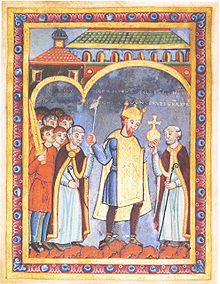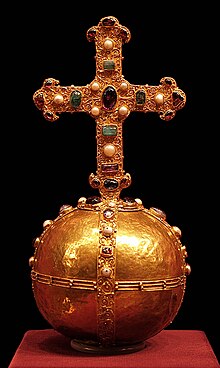Reichsapfel (imperial regalia)

The orb ( Latin globe Cruciger of globus "ball" crux "cross" and gerere "carry") of the Holy Roman Empire is one of the crown jewels . As an attribute of the Roman god Jupiter , the globe in the hand of the emperor or the Roman-German king as the future emperor was a symbol of world domination .
Together with the crown and the scepter , it was presented to the king during the coronation ceremony . These three insignia were very often used to represent kings and emperors in pictures. As a traditional component of a ruler's insignia , the imperial orb , which has been in the Viennese treasury since 1800 , has never achieved the specific meaning related to the individual piece, such as the imperial crown , the holy lance or the imperial sword .
Appearance
The imperial orb of the imperial regalia has a height of 21 cm and is made of gold , gold filigree and set with precious stones and pearls.
The sphere, which stylizes the globe, consists of a resin compound and is covered with sheet gold. The clasps along the equator , like those of the attached cross, were originally set with pearls. The stone at the intersection of the two cross bars is a sapphire and shows a monogram that is similar to that of the Merovingian kings, but has not yet been interpreted.
history
The orb goes back historically to the Greek Sphaira and the later globe of the Romans, which symbolized the world domination of the Roman Empire . On medieval and modern coins, the German emperors and kings are often depicted with the imperial orb in their left hand. The imperial orb is also depicted on coins of the Rhineland Count Palatine (electoral lines), because they held the office of orb , which was symbolized by the imperial orb ( orb ).
A first reference to an orb that was handed over is to be found shortly before the coronation of Henry II by Pope Benedict VIII on February 14, 1014. Benedict VIII and the Roman citizens went far to meet Henry II and gave him a solemn reception before Rome, whereby the Pope presented an imperial orb made of gold, set with precious stones and adorned with a golden cross, which he had previously made for the occasion. Heinrich II passed this orb to the Cluny monastery . Abbot Odilo von Cluny had celebrated Christmas with the court on December 25, 1013 in Pavia and was also present at the imperial coronation.
An imperial orb is also in 1191 at the imperial coronation of Henry VI. presented to the new emperor. The shape of the cross and the filigree ornaments suggest that this orb could not have been created much earlier. On the other hand, there is no evidence that the imperial orb, which is now kept in the treasury in Vienna, was presented to the emperor. Helmut Trnek writes:
"The traditional coronation insignia, including scepter and orb, were chosen at will from the hoard."
In addition to the richly endowed piece existed until Flüchtung the crown jewels of Nuremberg in 1796, two simple crafted orbs, but were lost in the turmoil. Thus formed Albrecht Dürer Charlemagne to his ideal of 1513 from one of the two copies simpler.
literature
- Hermann Fillitz : The insignia and jewels of the Holy Roman Empire. Schroll, Vienna et al. 1954, OCLC 4248103 .
- Heinrich Pleticha : The shine of the empire. Imperial regalia and coronations as reflected in German history. Herder, Freiburg (Breisgau) et al. 1989, ISBN 3-451-21257-9 .
- Karl-Heinz Rueß (Red.): The imperial regalia. Signs of rule of the Holy Roman Empire (= writings on Staufer history and art. Vol. 16). Society for Staufer History, Göppingen 1997, ISBN 3-929776-08-1 .
Web links
Remarks
- ↑ Helmut Trnek: imperial insignia . In: Lexicon of the Middle Ages (LexMA). Volume 7, LexMA-Verlag, Munich 1995, ISBN 3-7608-8907-7 , Sp. 623-626.
